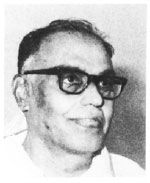- Volume 59 , Number 4
- Page: 656–7
T. N. Jagadisan October 2, 1909-June 28, 1991

The leprosy world lost a champion protagonist with the demise of Shri T. N. Jagadi san who had made the world his village and went wherever leprosy patients were found, raised their spirits, and organized succor for them. Shri Jagadisan was born on 2 October 1909 in Thachakkadu, a small town in South Arcot District of Tamil Nadu (South India) into a not very affluent Brahmin family. As a student he had a flair for the English language, in which he took the B.A. (Hons.) degree at the University of Madras amid great personal hardship. He taught for varying periods at Madura College, Madurai; Union Christian College, Alwaye; and Annamalai University, Chidambaram. In this last place he came under the influence of the great Indian liberal educationist and master of English, the Rt. Hon. V. S. Srinivasa Sastri, who was Vice-Chancellor of the University at that time, and imbibed from him not only a feel for the language but also a flair for public service. Shri Jagadisan had developed "noninfective leprosy" in his youth which left him with a neural deficit in his limbs and attendant problems. His personal experience of the travails of these problems and the wall of prejudice created by them, coupled with his passionate desire for service to a cause, made him decide to devote his life to changing the attitude of society toward leprosy patients to one of acceptance instead of rejection, and to make rational scientific treatment available to leprosy patients, not only in his native district and state, but all over India. It must be remembered that this decision was made in 1943, in the pre-sulfone era of leprosy, when compassion and charity were the main approaches toward leprosy patients and segregation the main method to contain leprosy.
Shri Jagadisan was adept at getting to meet the leaders of society, had the personality to make them life-long friends of his, and the wisdom and skill to influence them to develop "leprosy-friendly" policies and practices along modern scientific lines without losing the humanistic touch. In turn, he came under the spell of Mahatma Gandhi and Thakkar Baba for whom the plight of the leprosy patient was the epitome of human predicament and their identification of leprosy work with national reconstruction fitted nicely with his own nationalistic and humanistic aspirations. His early "leprosy friends" were Dr. R. G. Cochrane, Dr. Hemerijckx, and Dr. Paul Brand who incidentally gave him, as he puts it in his inimitable style, "brand new hands." A list of his other friends, as seen from his recently published autobiography Fulfillment through Leprosy reads like a "Who's Who" in Indian society for over half a century, and includes prominent persons from all walks of life, ranging from village chiefs to ministers, social workers, industrialists, prime ministers, presidents and vice-presidents of India, as well as leading scientists, missionaries and philanthropists interested in and working for the cause of leprosy all over the world. It is, therefore, no wonder that his services were sought after by state governments and the Government of India for shaping policies for leprosy control and for setting up leprosy institutions, rehabilitation homes and research centers, as well as by the British Empire Leprosy Relief Association and its later incarnation the Hind Kusht Nivaran Sangh (HKNS) of which he was a founder member and organizing secretary for many years.
Shri Jagadisan organized, with the blessings and guidance of Mahatma Gandhi and Thakkar Baba, the First All India Leprosy Worker's Conference at Wardha in 1947, and helped in the organization of similar conferences at the national level as well as in the different states of India for the next quarter of a century and more. The merits of his labors were well recognized the world over, and he was the recipient of many awards, including the award of Padma Shri from the President of India in 1957, the Silver Medal from Pope Paul VI in 1967, and the prestigious International Gandhi Award in 1988.
Shri Jagadisan was not content to be a mere preacher, and so he founded and developed Kasturba Kushta Nivaran Nilayam in Malawanthangal, South Arcot District, then a hot bed of leprosy with a prevalence rate of over 50 per thousand in some parts, as his center for practical work. He travelled widely, visiting institutions, advising administrators, chairing and participating in sessions on social aspects or rehabilitation in national and international gatherings, and entrancing everybody with the magic of his persuasive oratory. Shri Jagadisan has written extensively wherein he has advanced surprisingly progressive ideas on promoting social action and re-integration of leprosy patients in the mainstream of society. We are proud to have known him, and we will miss forevermore his resounding voice clearly articulating impassioned pleas for the uplifting of man through concern for the disabled and the discredited.
- H. Srinivasan